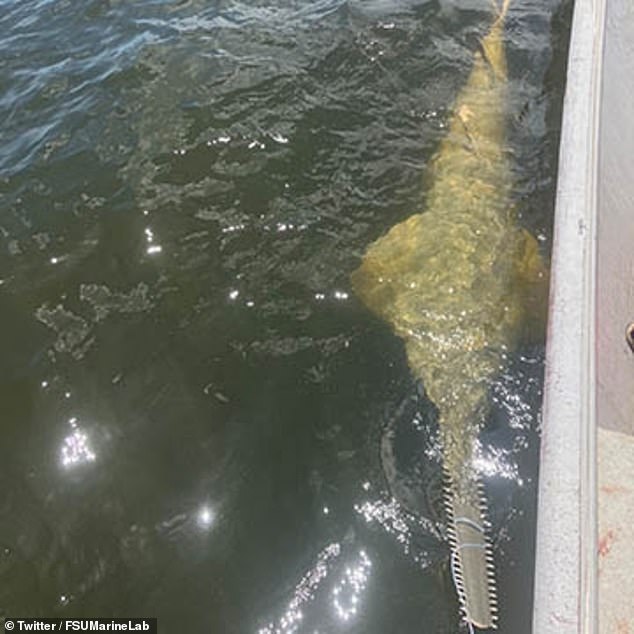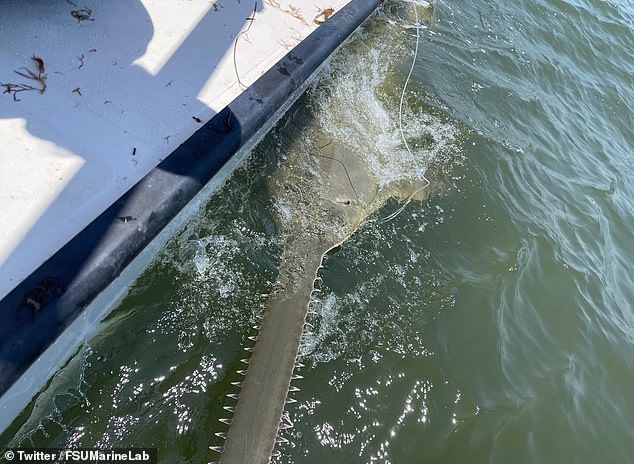Rare ‘prehistoric’ shark relative with 32 teeth on its exterior is making a comeback in Florida
Dr. Jim Gelsleichter and members of the University of North Florida Shark Biology Program were amazed when they captured and released a critically endangered sawfish.
He and four UNF students were exploring the St. Marys River this summer when they found the 10-foot-long, rare shark.
One of the students discovered the sawfish, a species that evolved from primitive sharks that are now extinct, after feeling a tug on the line in the water.
Gelsleichter, director of the UNF Shark Biology Program, jumped into the water to grab the line they use to catch large species.
“It was the heaviest thing I’d ever pulled on a drum line. When I pulled it, I thought, ‘Wouldn’t it be funny if it was a sawfish,'” Gelsleichter said. Today in the US.
Dr. Jim Gelsleichter and members of the University of North Florida Shark Biology Program captured and released a sawfish on July 16

Jim Gelsleichter, director of the UNF Shark Biology Program, jumped into the water to grab the line they used to catch large species and save the sawfish
Gelsleichter and the students on the 6.4-meter boat immediately began studying the fish after pulling it from the water on July 16.
According to the UNF press release, shark enthusiasts identified the sawfish as a male because it had claws and paired pelvic fin projections that male sharks use for reproduction.
They also found that the sawfish was immature, meaning it was young and not yet fully grown.
After seeing the heavily calcified and soft clamps, the UNF professor and students determined how old the sawfish was.
Several scientists, including UNF biologists who have studied sawfish reproduction, have confirmed that male sawfish usually do not reach full maturity until they are at least 3.5 meters long.

Gelsleichter and the students concluded that the sawfish was a male and sub-adult, meaning it was not yet fully mature
Gelsleichter was partly excited about this find because of the massive decline in the sawfish population since the 20th century.
The main reasons for the decline in the sawfish population are that they often get entangled in fishing nets and that their habitat is decreasing.
They were also the first marine fish to be listed as endangered under the U.S. Endangered Species Act in 2003.
“Sawfish were known to exist in northeast Florida before population declines led to the species being listed as endangered,” he said.
‘The return of the sawfish to our area is a positive sign of population recovery.’
Although the smalltooth sawfish population has increased since experts listed the species as endangered, there is a risk of the population declining again due to reports of sawfish kills in Florida, the UNF press release said.
Hundreds of fish, including more than 50 sawfish, died in the Florida Keys from a type of spinning disease, which can cause fish to spin and behave strangely.
According to Gelsleichter, the sawfish they encountered during their trip showed no signs of spinal disease.

The discovery of the sawfish came less than six months after more than 50 of them died in Florida from a spinning and whirling disease
Sawfish are known for their elongated, saw-like snouts, which they use to slice sideways through the water when hunting for a particular species.
There are five different types of sawfish: smalltooth, largetooth, dwarf, green, and narrow.
Each of these five species differs in size, geographic range, and physical characteristics such as the location of the dorsal fin and the shape of the caudal fin.
Smalltooth sawfish live mainly in tropical seas and estuaries in the Atlantic Ocean.
This sawfish species mainly eats fish, but can also eat various invertebrates, such as shrimp and crabs.
Their snouts also have an electrosensory system, which allows them to identify prey and detect the small amounts of electricity produced by other animals.
Florida residents hoping to spot a smalltooth sawfish have a good chance if they are on the southwest coast, near the Everglades and the Florida Keys.
If you don’t live in the US, you can find smalltooth sawfish off the coasts of Honduras, Belize, Cuba, Guinea-Bissau, and Sierra Leone.
Smalltooth sawfish usually live between 25 and 30 years, but the largetoothed species can live between 30 and 80 years.
